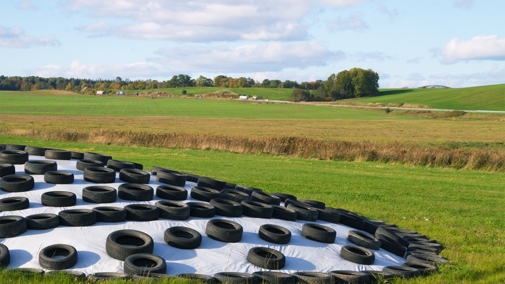Silage Feedout
Loss at the feeding face can drastically affect silage quality, even if care was spent to put up and store a good product. As temperatures warm, let’s review best practices for managing silage feedout.
Once we begin feeding and the pile is exposed to air, aerobic microbes and yeast reactivate, working to decompose the stored plant material. While some factors at feedout like packing density, pile shape and inoculation are beyond our control now, limiting the amount of oxygen introduced to the pile and feeding quickly can help maintain silage condition. If left unchecked, losses of greater than 25% dry matter can be realized.
Try to keep the pile covered as much as possible to reduce oxygen exposure. No one wants to be cutting off plastic daily, but limiting the amount removed at a time maintains an anerobic environment longer. Try not to expose more than three days’ worth of a pile at a time. Face management helps with this too. Try to maintain a smooth face, scraping from top to bottom to minimize jagged edges and cracks into the pile, exposing more of the surface to air.
Finally, let’s discuss feedout rate. As oxygen seeps into the pile through the face, we want to remove silage faster than it spoils. Temperature plays a role as warm temperatures (greater than 40°F) do not depress microbial growth the way winter temperatures do. Ideally, six to eight inches of the face should be removed daily to stay ahead of this oxygen front. University of Wisconsin research recommends no less than four inches of removal daily from piles/bunkers during the summer. Ideally, when planning a new bunker or pile, a removal rate of 12 inches per day should be planned for.
Quality silage can drop condition fast if feedout is poorly managed. Limit oxygen exposure by maintaining a smooth face, keeping plastic covering over as much of the pile as possible, and feeding out at rate of six to eight inches daily.
Grass Hay Harvest
Smooth bromegrass and other cool-season grass hay fields are growing rapidly and seedheads will soon be appearing. When do you typically cut your grass hay? Ideally, cutting your grass hay so the grass nutrient content matches with the nutritional needs of your livestock is best.
Crude protein and energy concentration declines in grass hay as plants become stemmy and mature. With smooth bromegrass, for example, research has shown that crude protein content declines rapidly between boot and mature seed stages. Crude protein levels in well fertilized hay harvested at early heading range from 10-18% but drop rapidly after heading. Decreases in crude protein levels by as much as 0.5% per day after heading have been recorded.
As this happens, the types of livestock that can be fed that hay with little or no supplements become more limited.
For Sandhills sub-irrigated meadows, haying typically starts in early July. However, if harvest occurs around the third week of June, then that hay will have significantly higher crude protein content. Earlier meadow harvest will have lower initial hay yield, but it will also provide a longer regrowth period and extra growth for fall grazing.
So, a good approach is to plan what type of livestock will receive the grass hay from each field. Young livestock need high nutrient concentrations so cut that hay before or just when heads begin to emerge. If the hay will go to mature dry cows instead, let the grass produce a bit more tonnage and cut it after it is well headed out, but before seeds develop.
Matching your hay harvest with your plan of use can pay handsome dividends in lower costs and less supplementing.
Grasshopper Management
The 2024 rangeland grasshopper risk map from the USDA indicates there may be increased grasshopper activity in central Nebraska and the Panhandle. Keeping an eye on fields this summer can help mitigate economic loss from grasshopper feeding.
Grasshoppers tend to thrive in dry, hot conditions. While outbreaks can be severely limited by cool, wet spring weather, it is still recommended that producers throughout the state scout their fields while grasshoppers are still in the nymph stage and therefore easier to control. While there have already been reports of large numbers of adult (flying) grasshoppers in central Nebraska, they are typically bandwing grasshoppers that rarely cause economic damage. If you are observing large numbers of flying adult grasshoppers and are concerned, contact your county extension office.
One of the best ways to scout for grasshoppers is to use the square foot method. Randomly select an area several feet away and visualize a one square-foot area around that spot. Walk toward this spot and count the number of grasshoppers you see in or jumping out of this area. Repeat this procedure 18 times and divide the total number of grasshoppers by two. This will give you the number of grasshoppers per square yard. Economic thresholds for grasshoppers range from eight to 40 grasshoppers per square yard, depending on a variety of factors. Keep in mind that control is generally recommended before grasshoppers reach the adult stage.
For current insecticide recommendations for controlling grasshoppers in rangeland, forages, alfalfa and other crops, please contact your county extension office.

